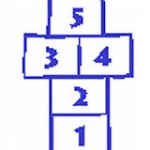Hopscotch – It’s Not Just For Sidewalks
Hopscotch is one of those games that grows up with children. They start out jumping on two feet from square to square, simply trying to get from one end to the other, and eventually learn a much more sophisticated game that includes one-footed tricks, spinning around, and tossing rocks into very small spaces.
I’ve written about hopscotch over the past few years (try here and here) as there are often very good examples of complicated and unusual formats on the sidewalks near my house. I like the idea of creating a hopscotch game in the classroom using tape for the outline and bean bags for the toss. I once used masking tape but it was a nightmare to get off, so try using painter’s tape, as it is designed for easy removal.
Start simple. Use the tape to create 5 spaces and once the children become comfortable with this, you can add more.
At first, encourage the children to jump with both feet in each space as they might be working on this skill before they are ready to hop on one foot and skip spaces. They can play cooperatively before they play competitively, simply taking turns tossing their bean bags and jumping or hopping through the course. There is plenty of time for complicated and cut-throat games of hopscotch later. For now, use this indoor version as gross motor opportunity that encourages number recognition, turn-taking, following directions, spatial relations, body awareness, and gross motor skill-building.

Hopscotch can be used for addition and subtraction as well. As children become familiar with the game and how it works, they can start to follow more complex directions such as, \”Hop to the number 5. Hop back one step. What number are you standing on?\” You can write out the equation 5-1=4